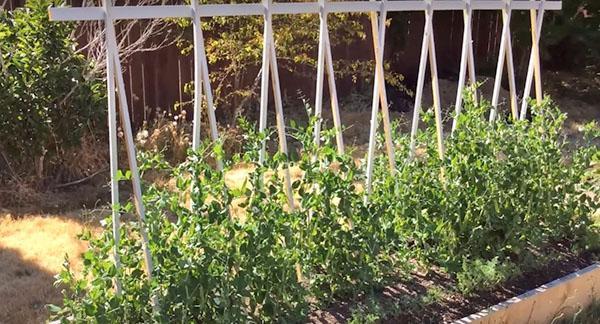Making a trellis for peas
 Peas are a climbing legume that takes root well in sandy loam and sandy soil. On light fertile soils, peas will yield the greatest yield.
Peas are a climbing legume that takes root well in sandy loam and sandy soil. On light fertile soils, peas will yield the greatest yield.
It is better to grow this leguminous plant in high beds, planting peas in two rows. To get a good crop of beans, you need to establish a support for the plant. Tall varieties of this delicious leguminous plant can grow up to 2 m in height.Let's consider two ways to make a trellis for peas.
The first way to install the trellis - "pea wall"
Place a support made of wooden beams between adjacent rows of peas. Pull the trellis net onto the improvised frame to cucumbersthat is sold at any gardening or hardware store. It can be 3 m or 5 m wide. Choose a net according to the size of your trellis.
When the peas begin to grow, they will cling to the trellis with their antennae: one row is on the right, and the second row is on the left. But first you need to help him catch on the net. To do this, direct each plant to the grid and fix it to the first row of cells, and then after a week the peas will independently climb up. A "pea wall" is formed.
If the width of your garden allows, then plant onion or dzhusai onion near the rows of peas, and you will have vitamin greens on the table throughout the summer season.
The second type of tapestry is grandma's "wigwam"
The second method of making a trellis is diagonal. Our grandmothers put such supports for the peas and called the trellis "wigwam". It is necessary to sharpen the pegs from wooden beams, placing the pegs so that their upper parts intersect with each other. In order for the supports to hold better, they are tied with wire.
For additional stability of the support, a transverse beam is placed on top. With such a beam, the trellis will withstand any loads and will not collapse from the wind.
The pegs are stuck into the soil at an angle of 60ABOUT between every two adjacent plants. The distance between two rows of peas is made wider by 20-30 cm than with the first planting method. Over time, these two neighboring plants will braid a peg, clinging to each other.
At the very beginning of plant growth, in order to help the peas twine around the support, you need to pull a rope at a distance of 20 cm from the soil, to which the young bushes will cling.